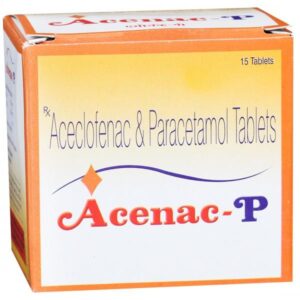PARACETAMOL (ACETAMENOPHEN) + ACECLOFENAC + ANTIOXIDANT
Paracetamol (acetamenophen): Paracetamol, also known as acetaminophen, is a commonly used over-the-counter medication used for pain relief and reducing fever. It belongs to the class of drugs known as analgesics (pain relievers) and antipyretics (fever reducers).
Paracetamol’s exact mechanism of action is still not fully understood. However, it is believed to work by inhibiting the synthesis of prostaglandins, which are chemicals in the body that contribute to the perception of pain and the generation of fever. By reducing the levels of prostaglandins, paracetamol helps alleviate pain and reduce fever.
The recommended adult dose of paracetamol for pain relief is usually 500mg to 1000mg (1 or 2 tablets). It can be taken every 4 to 6 hours, up to a maximum of 4 grams (4000mg) in a 24-hour period. The dose for reducing fever is also 500mg to 1000mg, but it is generally recommended to be taken every 6 to 8 hours as needed, not exceeding 4 grams in a day. It is important to carefully follow the dosing instructions and not exceed the recommended limits to avoid potential liver toxicity.
Paracetamol is generally considered safe when taken as directed. However, like any medication, it may have some side effects. The most common side effects include nausea, vomiting, and allergic reactions such as rash or itching. In rare cases, paracetamol can cause severe liver damage, especially when taken in high doses or in combination with alcohol. It is important to seek medical attention immediately if any signs of liver damage, such as dark urine, yellowing of the skin or eyes, or abdominal pain, occur.
Overall, paracetamol is a widely used and effective medication for pain relief and fever reduction. However, it is important to use it responsibly, follow the recommended dosing instructions, and consult a healthcare professional if you have any concerns or questions.
Aceclofenac: Aceclofenac is a nonsteroidal anti-inflammatory drug (NSAID) that is used to treat pain and inflammation associated with conditions like osteoarthritis, rheumatoid arthritis, ankylosing spondylitis, and other musculoskeletal disorders. It works by reducing the production of certain chemicals in the body that contribute to pain and inflammation.
Aceclofenac is available in tablet form and is usually taken orally with or after food. The usual dose for adults is 100 mg to 200 mg per day, split into two doses. The dose can be adjusted based on the severity of the condition and the individual’s response. It is important to follow the prescribed dose and duration of treatment recommended by a healthcare professional.
As with any medication, Aceclofenac may cause some side effects. Common side effects include stomach discomfort, heartburn, gastrointestinal ulcers, nausea, vomiting, diarrhea, headache, dizziness, and skin rash. In rare cases, it can also cause more serious side effects such as gastric bleeding, liver problems, kidney damage, allergic reactions, and increased risk of cardiovascular events. It is important to seek medical attention if any severe or persistent side effects occur.
Certain precautions should be taken while using Aceclofenac. It is not recommended for people with a history of gastrointestinal bleeding, peptic ulcers, severe liver or kidney disease, heart failure, or allergy to NSAIDs. It is also not recommended for use during pregnancy, breastfeeding, or in children below 18 years old unless specifically prescribed by a doctor.
As with all medications, it is important to consult with a healthcare professional before starting Aceclofenac to discuss any potential interactions with other medications, pre-existing medical conditions, or allergies. It is also important to disclose any history of gastrointestinal or cardiovascular disorders.
Overall, Aceclofenac is an effective NSAID used to manage pain and inflammation associated with various musculoskeletal disorders. However, like all medications, it should be used under medical supervision and with proper caution to minimize the risk of side effects.
Antioxidant: Drug Name: Antioxidant
Use: Antioxidants are substances that inhibit oxidation processes in the body. They are commonly used to neutralize harmful free radicals and reduce oxidative stress, which is linked to various diseases including cancer, heart disease, and age-related macular degeneration. Antioxidants are also believed to have anti-aging properties and improve overall health.
Mechanism of Action: Antioxidants work by stabilizing and neutralizing free radicals, which are highly reactive molecules produced during normal cellular processes or in response to external factors like tobacco smoke, radiation, and air pollutants. Free radicals can damage cells and DNA, leading to chronic inflammation and increased risk of diseases. Antioxidants donate electrons to free radicals, thereby neutralizing their harmful effects and preventing further damage.
Dose: The dose of antioxidants varies depending on the specific compound being used. Some antioxidants, like vitamin C and vitamin E, are often obtained through dietary sources or supplements. The recommended daily intake of vitamin C is around 75-90 mg for adults, while vitamin E intake ranges from 15-20 mg daily. Other antioxidants, such as selenium, can be found in certain foods or as supplements. The dosage should be determined by a healthcare professional based on an individual’s specific needs and health conditions.
Side Effects: Antioxidants are generally considered safe when consumed in reasonable amounts through food sources. However, high doses of antioxidant supplements may have side effects. For example, excessive vitamin C intake can lead to diarrhea, nausea, and stomach cramps. Vitamin E supplements can increase the risk of bleeding in individuals taking blood-thinning medications. Additionally, some studies have suggested that high-dose antioxidant supplements may actually increase the risk of certain diseases, including cancer. It is important to consult with a healthcare professional before starting any antioxidant supplements to determine the appropriate dosage and potential risks.

